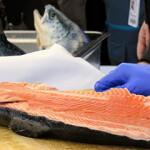Fish farmers worldwide face growing scourge of anti-microbial resistance

Aquaculture has been identified as a major global source of anti-microbial resistance (AMR), an issue of particular concern in low- to middle-income countries (LMIC) in Africa and South Asia.
The paper, "Aquaculture at the crossroads of global warming and antimicrobial resistance," was published in Nature in April. In the paper, its authors acknowledged that more farmed fish is needed to feed a growing global human population and to help meet the 2030 United Nations’ Agenda of Sustainable Development Goals (SDGs).
Fish and seafood consumption is expected to increase by 27 percent by 2030, the researchers forecasted, with the aquaculture sector growing by 62 percent on its own. The paper projected that aquaculture will play an increasingly important role in food security and poverty alleviation. However, researchers warned that in order to achieve the SDGs, better husbandry practices would be necessary to reduce or negate the negative impacts of the increased fish production.
In many areas, intensification of fish farming goes hand-in-hand with overcrowding of cages and is associated with resultant environmental and health hazards such as increased water use and overuse of antimicrobials. In LMIC areas, where fish farming tends to rely heavily on antibiotics to prevent and control disease outbreaks, use of pharmaceuticals is expected to increase over time, the paper stated.
While the obvious answer to the problem is to reduce the number of fish kept in each pond or cage system, the result of that would be a reduction in yield, which is unlikely to be acceptable to poorer LMIC farmers and also compromises the economic advantage to their coastal communities, according to the paper.
The researchers noted that vulnerability to climate change and the local spread of AMR in human pathogens are directly correlated. There is also evidence to suggest that rising water temperatures resulting from climate change could increase the severity of some fish diseases, they explained. This is likely to lead to an ever-greater reliance on antibiotics, as the oceans continue to heat.
Rates of AMR are already growing in countries with poor infrastructure, as they lack the resources to monitor the spread of resistance in hospitals, the paper noted. AMR bacteria are responsible for more than 35,000 human deaths per year in the U.S., 33,000 deaths in the European Economic Area, and 58,000 deaths in India.
Studies have shown that while the precise quantities of antimicrobials used in aquaculture remain mostly unknown, particularly in LMICs, testing of aquaculture environments has often yielded the presence of antibiotic residues and AMR bacteria.
Aquatic environments may contain AMR bacteria from human waste water, hospital effluents, and animal and plant agricultural run-off. The direct contribution of aquaculture, while hard to quantify, is likely to come from the use of therapeutic and prophylactic antimicrobial treatments and also from disinfectants, which have also been shown to increase AMR, researchers said.
In wealthier northern hemisphere countries where aquaculture systems are more advanced, fish farmers are able to make use of solutions like vaccination programs to improve animal welfare and increase disease resistance. This works well in salmon, but may be too expensive or unsuitable for species farmed in developing countries, or where animals are infected by multiple opportunistic pathogens, the paper explained.
Probiotic food supplements aimed at boosting fish growth and immunity have been used to the advantage of wealthier countries for many years. They are now gaining widespread use in Southeast Asia as an affordable and sustainable solution to fish and shellfish health challenges.
Medicinal plants are a cheap and commonly used solution adopted by fish farmers in some LMICs, while others practice forms of polyculture, growing fish and prawns together in rice fields, or fish with edible seaweed. However, strategies that shift away from antibiotic use require time, investment, and short-term loss of productivity – but are worth the effort in order to decrease the dependence on pharmaceuticals, according to the researchers.
Recirculation aquaculture systems are increasingly seen as a panacea for most fish farming ills in more affluent countries, but such high-tech solutions require levels of investment that are unlikely to be available to LMIC farmers. In addition, aquaculture that is undertaken in areas away from the sea could disrupt hundreds of years of local and family tradition, and disrupt coastal communities.
There is no one simple solution to limiting antimicrobial use and the global spread of AMR, but action is urgently needed, according to the paper. To do this, coordinated national and international interventions will be needed to overcome the challenges faced by political and scientific communities.
At a local level, communication between the fishing community and local healthcare experts will be key, as will careful and coordinated monitoring for disease in fish and humans, the researchers said.
Photo courtesy of kataleewan intarachote/Shutterstock






Share